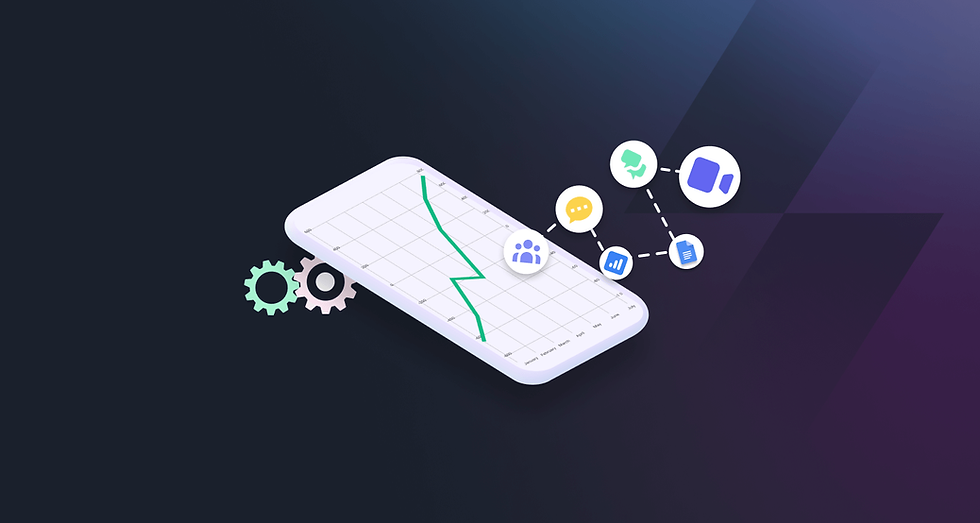Best Productivity Apps for Remote Teams 2025
- Abhinand PS
.jpg/v1/fill/w_320,h_320/file.jpg)
- 1 day ago
- 4 min read
Introduction: Why Remote Teams Need Productivity Apps in 2025
With remote and hybrid work becoming the new normal in 2025, managing productivity while working from home is a top priority for businesses worldwide. Team leaders are no longer asking “Can remote teams work effectively?” — instead, the question is “Which tools can make remote teamwork seamless and efficient?”
From video conferencing to project management and time tracking, productivity apps now play a crucial role in ensuring smooth communication and collaboration across distributed teams. After testing and consulting with multiple small and medium-sized businesses, I’ve compiled a comprehensive list of the best productivity apps for remote teams working from home.

Quick Comparison: Top Productivity Apps for Remote Teams 2025
App Name | Best For | Standout Feature | Free/Paid |
Slack | Real-time team communication | Channels + third-party app integration | Free + Paid |
Trello | Visual project management | Drag-and-drop Kanban boards | Free + Paid |
Asana | Task management & workflow | Timeline + automation features | Free + Paid |
Zoom | Video conferencing | HD video + breakout rooms | Free + Paid |
Notion | All-in-one workspace | Notes, docs, databases, wikis | Free + Paid |
ClickUp | Remote work management | Everything-from-tasks-to-chat | Free + Paid |
Toggl Track | Time tracking | Intuitive reports & team logs | Free + Paid |
Google Workspace | Document collaboration | Cloud-based work suite | Free + Paid |
1. Slack – Seamless Team Communication
Slack is still one of the best team collaboration tools for remote teams in 2025.
Create channels for different projects or teams
Integrate with Google Drive, Zoom, and Trello
Searchable history for quick access to past discussions
💡 Pro Tip: Use Slack’s built-in huddles and stand-ups to replace unnecessary video meetings.
👉 Related: Top Collaboration Hacks for Remote Teams
2. Trello – Visual Project Management at Its Best
If your team prefers simplicity, Trello is the ideal choice.
Drag-and-drop cards for easy task tracking
Custom workflows with labels, deadlines, and checklists
Integrates seamlessly with Slack and Google Workspace
Great for startups and small remote teams who want clarity without complexity.
3. Asana – Scalable Workflow for Growing Teams
Asana is perfect for remote businesses that want more than just task lists.
Create timelines and Gantt charts
Assign roles, deadlines, and recurring tasks
Automate workflows with rule-based triggers
💡 Many businesses I’ve worked with use Asana templates to speed up onboarding for new projects.
4. Zoom – Still the King of Remote Meetings
Even with competitors like Microsoft Teams and Google Meet, Zoom continues to dominate video conferencing.
Crystal-clear HD video and audio
Breakout rooms for team discussions
End-to-end encryption for secure meetings
For distributed teams, Zoom integrates directly with calendars and project management tools, ensuring synchronization across workflows.
5. Notion – The All-in-One Workspace
Notion combines notes, project management, and databases — making it a Swiss Army knife for productivity.
Share wikis, meeting notes, and SOPs with your team
Create collaborative dashboards
Flexible templates for content calendars, task lists, and CRM
💡 Notion is especially useful for documentation in remote startup environments.
6. ClickUp – One Platform for Everything
ClickUp is one of the fastest-growing tools for remote work.
Offers task management, docs, goals, chat, and even mind maps in one place
Custom dashboards for managers and remote workers
Time tracking + productivity monitoring
This eliminates the need to subscribe to multiple different apps.
7. Toggl Track – Smarter Time Tracking for Teams
Time management is critical in remote work. Toggl Track helps teams:
Log hours across projects
Export reports for payroll and invoicing
Identify productivity patterns
💡 Great for freelancers and small agencies working remotely.
8. Google Workspace – The Collaborative Cloud Suite
Google Workspace (Docs, Sheets, Drive, Meet, Gmail) remains essential for real-time collaboration.
Multiple team members can work on files simultaneously
Powerful commenting + suggestions features
Works seamlessly on mobile and desktop
Pro Tips for Choosing the Best Productivity Apps in 2025
Start with free versions before upgrading to paid plans
Choose tools that integrate with each other (Slack + Trello + Google Workspace make a powerful trio)
Focus on ease of use — overly complex tools reduce adoption rates
Prioritize tools with mobile accessibility to support teams working on-the-go
FAQ: Productivity Apps for Remote Teams Working from Home
1. What is the best productivity app for remote teams in 2025?
It depends on your use case. For project management, Asana or ClickUp. For team communication, Slack. For documentation, Notion.
2. Are free productivity apps enough for remote businesses?
Yes — tools like Trello, Slack (free tier), and Google Workspace (basic version) are enough for small teams. However, scaling teams often need advanced paid features.
3. How do productivity apps improve remote work efficiency?
They centralize tasks, streamline communication, and reduce time wasted on emails and meetings. Teams can collaborate in real time, track goals, and stay accountable.
4. Which apps are best for hybrid teams?
Apps that combine asynchronous + synchronous communication, like Slack + Zoom, work best for hybrid setups.
Final Thoughts: Building a Productive Remote Team in 2025
In a world where remote work is the default, productivity apps act as the digital office infrastructure for small, medium, and large businesses alike. The key isn’t to use every tool available, but to pick 3–4 apps that integrate smoothly and fit your remote team culture.
When your team has the right productivity apps, working from home doesn’t just match traditional office efficiency — it can surpass it.



Comments